![]() Having gone to bed in the Sea of Japan, we awoke in South Korean coastal waters of the East Sea. Heading to the top deck of the overnight Kampu Ferry from Japan to see where we were, we could see small, craggy islands surrounding us with the port of Busan in the distance. The ferry must have anchored sometime during the night, which meant that we would have time for a quick breakfast before it would be time to shoot the harbor.
Having gone to bed in the Sea of Japan, we awoke in South Korean coastal waters of the East Sea. Heading to the top deck of the overnight Kampu Ferry from Japan to see where we were, we could see small, craggy islands surrounding us with the port of Busan in the distance. The ferry must have anchored sometime during the night, which meant that we would have time for a quick breakfast before it would be time to shoot the harbor.
(Did you miss “The Mysteries of the Kampu Ferry, Part I”? Read it here.)
We descended down to the cafeteria deck and walked through the mostly empty halls with the ship’s speakers still playing muzak version of Beatles songs, only now at a lower volume due to the early hour. At the cafeteria, we pushed our desired buttons on the bizarre food-o-matic machine and sat down to eat. A few gulps of coffee, a hard boiled egg and some toast for Meade and a light seafood and rice combo for RB, and we were back up top as our ferry, the m/v Hamayuu, was beginning its passage into the harbor. 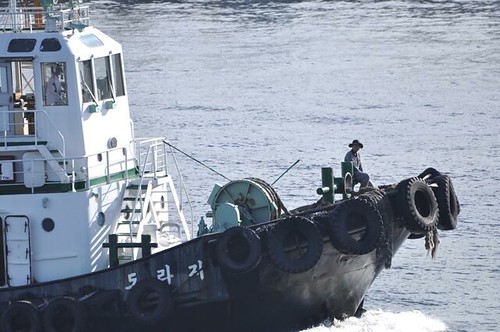
Amid the slightly larger rocky outlying islands, international cargo ships, massive construction works and the aircraft carrier USS George Washington, the Hamayuu made its way toward the docks of Busan, our gateway to mainland Asia. It was a slow approach, but we needed it – there was too much to shoot.
The tugs, the ships they supported and the dockworkers took up RB’s time while Meade focused on the docks themselves, the massive diamond-shaped bridge support under construction and the approaching city of Busan itself. As we did the day before, we criss-crossed one another, running across the decks to find the best shots. No one bothered us the whole time – the other passengers either left us alone or weren’t impressed enough with the harbor to get in our way.
We could just make out the morning announcements from the loudspeakers of the Washington, which had only recently come to Busan from its station in Japan. When one of our Busan cabbies would later ask if we were servicemen aboard the ship, it was just easier to say “No” than to explain that “No, but we passed by her while on our Japanese shopping ferry on our way into Korea to pick up our friend to take her to Taiwan.”
As we passed the docks, shipyards and the other vessels of the harbor, looking through our zoom lenses and into one of the buildings near the center of the crescent-shaped harbor, we could make out a Korean Young Bob, cameraphone in hand, taking in all the activity of the port. It was like looking into the future past of College Point, Queens – if in twenty years Korean Young Bob takes a ferry into New York and sees us there, the circle will be complete.
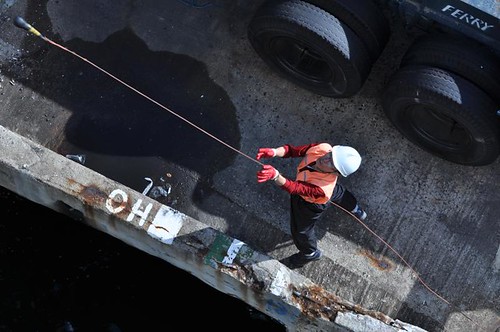 Still shooting as the Hamayuu was nearly at its berth, we didn’t notice the thinning amount of other passengers on the top decks with us. Soon, the ship’s announcements began to get louder in the background and became a touch more urgent. We went back down to our cabin to begin packing up when a deckhand knocked on the door, all but ordering us to immediately leave the room. As far as we could tell, we were the last people still in their rooms on our deck.The ship docked, and once we left the customs house we were right in downtown Busan, surrounded by glistening office buildings, rolling hills in the distance and a whole new country to dive into. We made our way to subway station where, after an elderly lady helped us with the fare machines – and who spoke more Engrish to us than we had heard during our entire time on the ferry – we noticed something odd. Right on the subway platform was a glass case full of gas masks.
Still shooting as the Hamayuu was nearly at its berth, we didn’t notice the thinning amount of other passengers on the top decks with us. Soon, the ship’s announcements began to get louder in the background and became a touch more urgent. We went back down to our cabin to begin packing up when a deckhand knocked on the door, all but ordering us to immediately leave the room. As far as we could tell, we were the last people still in their rooms on our deck.The ship docked, and once we left the customs house we were right in downtown Busan, surrounded by glistening office buildings, rolling hills in the distance and a whole new country to dive into. We made our way to subway station where, after an elderly lady helped us with the fare machines – and who spoke more Engrish to us than we had heard during our entire time on the ferry – we noticed something odd. Right on the subway platform was a glass case full of gas masks.
We weren’t in de-milified Japan anymore. Over the past decade, the sight of soldiers carrying high-powered rifles in New York’s main train stations has become a common sight, but this was taking “homeland security” to another level. Not merely concerned with terrorism, these gas masks were the first sign that South Korea was acutely aware of the possibility of an attack from North Korea… which wasn’t surprising considering that the two countries have been at war for over sixty years now. (Fun Fact: The Korean War never technically ended: America and South Korea have merely been engaged in a long-term truce with North Korea all this time.)
Soon our train came, and we rode it out to Busan’s beach community of Haeundae. For two days we ate Korean BBQ, swam in the Pacific, visited the PC bangs, strolled the fish markets and hunted down the mysterious Jasal Bawi suicide rock before taking a train north to Seoul.
Read The Mysteries of the Kampu Ferry, Part I: Leaving Japan here
See the full photo gallery on Flickr:

Essay by Dan Meade
Photos by Rob Bellinger & Dan Meade
Date of voyage: 7/24/10
Date of Publication: 10/2/11
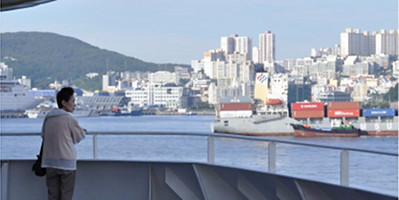
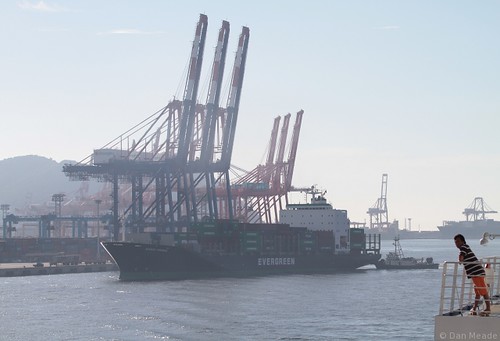
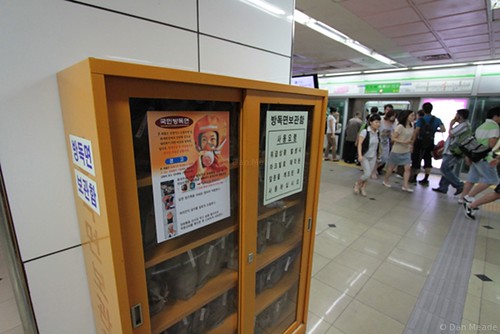
2 Comments